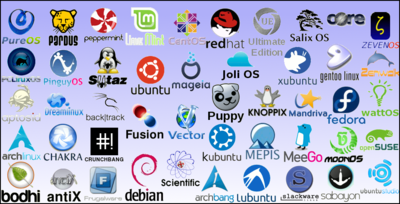Linux Landscape - A sea of confusion?
by Paul Arnote (parnote)

Which Linux distribution?
So which Linux distribution should a new user start with? Just take a look at the list on the front page of Distrowatch.com—this is a list of the top 100 Linux distros! Can you imagine trying to choose which “version” of Linux to trial, from a list of 100? In the “Windows World,” users have only four or five versions of Windows to choose from.
The list of 100 top Linux distros is only the tip of the iceberg. According to Operating-System.org, there are 605 different Linux distros. Distrowatch (as of May 1, 2011) lists even more (681), and breaks the list down to active (319), dormant (56), discontinued distros (306), as well as listing 247 as being “on the waiting list.” Granted, some of those in the list are no longer around. Yet when a new user is faced with the choice of over one-half of that number, say 300+ different Linux distributions to choose from, armed with nothing more than a desire to leave the Microsoft and Apple merry-go-round, it’s a miracle that even some of them discover Linux to be a workable alternative.
Choose wrongly, and the new user will get a bad feeling for Linux. They will run off, into the night like Paul Revere on his midnight ride, decreeing that Linux is not yet ready for “prime time” and that “Linux sucks” to anyone who will listen. Choose correctly, and that same new user will wonder why they didn’t switch sooner, and how they ever survived without Linux. That initial experience with Linux will be highly dependent on how well their hardware is detected, and the stability of the Linux distro that they chose.
Choose something like Fedora, which is considered to be more “cutting edge” than most other distros, and you may end up with stability issues. Choose something like Debian or PCLinuxOS, which have reputations of having only the most stable applications in their repos, and you are likely to have a very stable system.
Some computer users switching to Linux rely—rightly or wrongly—on the advice of a well-meaning friend. This can end up being a double-edged sword, depending on the level of experience the “friend” has, coupled with their proficiency with Linux. Taking the advice of a friend who has neither could spell a recipe for disaster, while taking the advice of someone with a fairly good level of experience and proficiency can help the new user make a smooth transition. The latter is only possible if the friend is capable of breaking things down into an easy-to-understand manner, and as long as the friend doesn’t forget that they also had to learn Linux from the ground floor. With some people, that higher level of proficiency and experience can be something that turns new users away from Linux, if the assistance isn’t conveyed in a constructive and encouraging manner.

One thing that certainly does not help is the users of one Linux distro bashing and bad-mouthing the users of another. Nor does it help to have overzealous fans singing the praises of one Linux distro over another with claims that are not easily substantiated or claims that are more a product of hype and other unrealistic claims. Typically, the old adage “if it’s too good to be true, it probably is,” tends to ring true. The distro bashing and fan boy claims turn potential new users off, and often make it appear that even Linux users cannot even get along with one another. It often appears as if there is a civil war brewing among Linux users.
With the free, open source nature of Linux, distro bashing is much like shooting yourself in the foot—and in the end, it may end up shooting us somewhere much more vital. Since Linux is FOSS (free, open source software), many distros “borrow” from one another all of the time. Even in PCLinuxOS, it’s not uncommon to see a mix of ideas borrowed from other distros, without prejudice. If it works, why not use it? This is also one of the reasons that distro-bashing in the PCLinuxOS forum is not allowed.
Imagine this, if you can. You need a new tail light for your 1991 Chevy Corsica. You go down to the salvage yard. They tell you they don’t have any 1991 Chevy Corsicas that you can get the part off of, but they have a 1992 Buick Skylark, which used the same tail light. (By the way, I don’t really know if the two tail lights are the same. I’m simply using this situation as a metaphor to illustrate my point.) Would you pass on the tail light, just because it came from a Buick Skylark, and not a Chevy Corsica, despite the fact that it’s the very same tail light, both made by General Motors? We all are running Linux, and all Linux distros borrow ideas and code from one another. So, by bashing another Linux distro, we are doing nothing more than bashing ourselves.
Desktop Choices
As if it isn’t bad enough to wade through 300+ Linux distributions, now the user will have to choose which desktop environment to use. For users coming from an environment where there primarily is one desktop environment available, they all of a sudden get hit with probably no fewer then 100 different choices about how to interact with their computer desktop. Even with PCLinuxOS, users have no fewer than six choices: KDE, Gnome, Xfce, LXDE, e17 and Openbox, with possibly even more choices in the future.
Add into this the distinction between a desktop environment and a window manager, and how those lines sometime become quite blurred, it’s perfectly understandable that new Linux users will have some confusion about what they should use.
To be fair, many of the desktop environments and window managers are mostly niche players, and haven’t gained widespread acceptance. Nonetheless, they still exist. It would probably be best to restrict new users to the most popular desktop environments, such as Gnome, KDE, Xfce, LXDE and e17. Of those five, KDE is the desktop environment that is most like Windows, which may make it one of the easiest ones for Windows refugees to adapt to and adopt.

Why, you may ask? Since there are more Linux users using those desktop environments, it will be easier for the new user to find help when they get into a bind. Also, many of those desktop environments operate a lot like the singular desktop environment they arrived from, so the new user can concentrate on learning the differences of Linux, compared to that “other” commercially available operating system. Given the chance to adapt to the Linux file system and other differences in Linux will help ease the new user into total adoption of Linux as their primary—or even sole—operating system.
Attitudes & Perceptions
Once a new user has chosen a distro and desktop environment, the next hurdles to jump are the attitudes of some Linux users, as well as the perception of Linux. Don’t underestimate the impact of these two items—they can make a formidable barrier for the new Linux user.

Let’s start with perceptions, first. Linux is seen as being closely related to Unix, which has been used in scientific circles for … well, forever. As a result, Linux is seen as the playground for “geeks.” Linux also has a common, albeit wrong and undeserved, perception of being for hackers.
While it is true that Linux is used in many scientific circles, this fact should stand as a testimonial to Linux’s flexibility, as well as its abilities. Linux gained these inroads into scientific circles precisely for these reasons, coupled with its security, both for user data and its core components.
Today, using Linux on a home computer is no more difficult than using any of the commercially available operating systems. All operating systems have a learning curve, whether it’s Windows, OSx, Linux, or anything else. No one was born knowing how to run any of them. Despite that, Linux has the reputation of being the “secret weapon” of hackers, and one where you are always having to tweak and mess with your computer. However, nothing could be further from the truth. Personally, I do less tweaking and messing with my computer running Linux than I ever did running Windows. Things just work. Period. As far as being a hacker’s playground, there are just as many “hacking” tools available for the commercially available operating systems as there are for Linux.
Attitudes are another thing, and one that won’t go away any time soon. Although not the way practiced in the PCLinuxOS Forum, there are still many other Linux forums where questions from new users are greeted with “RTFM” (Read The Freaking Manual, except another word is most often substituted for “freaking”)—or one of about a dozen versions or derivatives on that same theme. Among some who are more experienced with Linux, it’s as if they view it as a “rite of passage.” Because they, (the experienced users), had to figure stuff out on their own, mostly by reading the manual and other documentation for a program, they think EVERY Linux user should have to do the same.

Such attitudes give Linux the reputation of being for elitists, and it’s a reputation that Linux needs to shed. As Linux grows in popularity—and its popularity is on the rise—there is no need for these attitudes towards new users. There is now enough of a Linux user base that help should not be far away. While I applaud those who had to endure the lack of support and the “figure it out on your own” early days of Linux, and survived, making it easier for new users to adopt Linux and avoid the rituals of the early days of Linux should be the norm, and not the exception.
After all, these days, there is a larger Linux user base—one that is growing larger every day—than in days gone by, and it’s no longer necessary to force new users to “pay their dues” just to be able to run Linux. Being friendly to and offering to help new users is a great step towards retaining those users. They sought out Linux not because they had to, but because they wanted to.
Free vs Paid
In many Western cultures, there is a commonly held belief that things of value have a higher price attached to them. There is a large group of computer users who feel that if Linux had any real value, then someone would be charging for it. They simply don’t understand the very different business model that Linux operates under. How can development continue, especially at the current pace, when you give away the end product?

What isn’t visible to many is that much of the development is funded by many heavy-hitters and big players in the computing industry. This includes companies like IBM, Hewlett-Packard, Cisco, Red Hat, Google, the Mozilla Foundation, and many others. Let’s take Red Hat as an example. Red Hat markets Red Hat Enterprise Linux, which is a version of Linux with paid enterprise support. It’s not the actual operating system that is being sold. Rather, it’s the paid support that is sold. Red Hat makes its money from selling that support. IBM makes money selling an enterprise version of Linux, as well as the equipment to run it on.
Many companies profit from contributions to the Linux code base by not having to pay licensing fees for the use of commercial operating systems. In fact, Linux shows up in some of the most unlikely places. It serves as the operating systems that run DVD players, menus on TVs, cell phones, and many other consumer electronics goods. From working in a hospital, I can tell you from first hand experience that it also shows up in medical testing equipment. Linux is everywhere today.
As it turns out, the financial contributions to improving Linux come at a far less expensive price than licensing commercial operating systems. Employing teams of Linux programmers to make those improvements, to tweak Linux to do what they need Linux to do on these various devices, benefits not only themselves, but the entire Linux FOSS community as a whole.

Community developers, usually those who do it for pride and to learn, then take those contributions and further enhance them, which in turn, further benefits those companies who are funding development. Fedora Linux is (more or less) the free version of Red Hat. Things are developed and tried with Fedora, and those items that work, along with the information learned, then make their way to Red Hat Enterprise Linux.
So, as you can see, there is a symbiotic relationship between those who fund and contribute to Linux development and the Linux FOSS community. Both benefit from the continued development of Linux.
You may be wondering then, how community based distros, like PCLinuxOS, survive and get by. Quite simply, they survive from donations from the community of users that use it. The money that is donated goes to pay the living expenses of the main, lead developer (Texstar, in the case of PCLinuxOS), as well as the server expenses to host the ISO’s of the distro and the programs in the repository. Instead of paying $300 to $400 every couple of years for a copy of a commercial operating system, users pay $25 (or more—your conscience is your guide) to the developer to help keep development going. No one is getting rich from development of community based distros. Just ask Texstar. He’ll give you an honest answer.
As a matter of public record, there are Linux distros that are largely funded by the financial wealth of individuals, much as Ubuntu receives a significant amount of its funding from Mark Shuttleworth, who started Canonical. This situation, however, is the exception, and not the rule. PCLinuxOS does not have any wealthy individuals underwriting and backing its continued development. Instead, it survives purely on the generosity of its users and the donations they make.
Other cost savings to users of Linux come from the use of not only a FOSS operating system, but by also the use of FOSS programs in its repository. Sure, Linux doesn’t have the use of Microsoft Office. Instead, we have the use of LibreOffice. Instead of paying another $200 or more for the use of an office suite, we use LibreOffice for free. All across the board, virtually every program used on Linux is free software, whose development is largely funded in the same way as Linux itself. Linux users save even more by not having to purchase not only the software that is used on a day-to-day basis, but also by not having to purchase anti-virus, anti-spyware and anti-malware software. To date, there are no Linux viruses in the wild. So (at this time) it is pointless to run anti-virus software on Linux—unless you are trying to help protect Windows users who may receive files from you.
Summary
Don’t get me wrong. There is a lot of good about Linux. I love Linux. I wanted to try to take a look at Linux from the view that a new user, fleeing the tyranny of the closed source operating systems produced by Microsoft and Apple. Once we, as the Linux community, stand in their shoes and try to understand how they see things, the more we’ll see Linux grow.
I also wanted to take a look at Linux from the viewpoint of its detractors, and in the process, try to dispel some of the misconceptions and misinformation. By doing so, it gives all of us a better understanding.
Is Linux for every computer user? Probably not. Some folks needs are perfectly served by Windows. Some folks computing needs are perfectly served by OSx. Should every user switch to Linux? Probably not. At the very least, users should at least know that another option does exist. As it stands now, many do not even know that Linux exists.
The answers for getting the word out about Linux are not clear. With no traditional funding, there is no way to pay for advertising. For now, word about Linux is spread by “word of mouth,” and that looks unlikely to change anytime soon.
So, is there anything we, as Linux users, can do? Absolutely. First, we can stop bashing one another. Despite calls for Linux distros to band together to create fewer, larger distros, I do not believe that is necessary. In fact, I take a more Darwinian approach, where those distros that are most fit and that best support the needs of their users will be the ones that survive. Those that do not best support the needs of their users and that are not fit, for whatever reason, will not be able to continue. There will always be niche distros to cater to the specialty needs of small groups of Linux users. However, continuing to bash one another for using one distro over another has to stop. We are all, after all, using Linux. We have that kinship with one another.
Secondly, you can help spread the word about Linux. In doing so, be careful to avoid outrageous claims. Just stick with simple facts. If given a chance, Linux will sell itself. The work of the developers will sell Linux.
Third, help new users. Avoid the use of “RTFM.” The days of “paying your dues” is behind us, as well it should be. Linux users have now grown to such numbers that there should be plenty of help to go around to those users who willingly and voluntarily come seeking Linux.
Fourth, show potential new users your Linux desktop. Show them how many of their learned computer skills will transfer to Linux. Show them how their daily computing needs can be met with an operating system that doesn’t cost them a week’s wages.
While we won’t be able to afford big advertising budgets or be able to pump huge amounts of cash into a distro, there are lots of things each of us can do to help Linux gain the respect and loyalty of those new users. They are, after all, the future of Linux.
Most of us sought refuge with Linux. In fact, very few of us actually started our computer usage with Linux as our primary operating system. Most of us actually started with Windows. As such, it makes little sense to make new Linux users “pay their dues.” By helping to make the transition as smooth as possible, by offering the assistance that new users will undoubtedly need, we can retain a larger percentage of those new users. If Linux is to grow and prosper, as it can and should, we need to encourage those new users to stick around, especially since they came willingly to seek a viable alternative to the commercial operating systems.